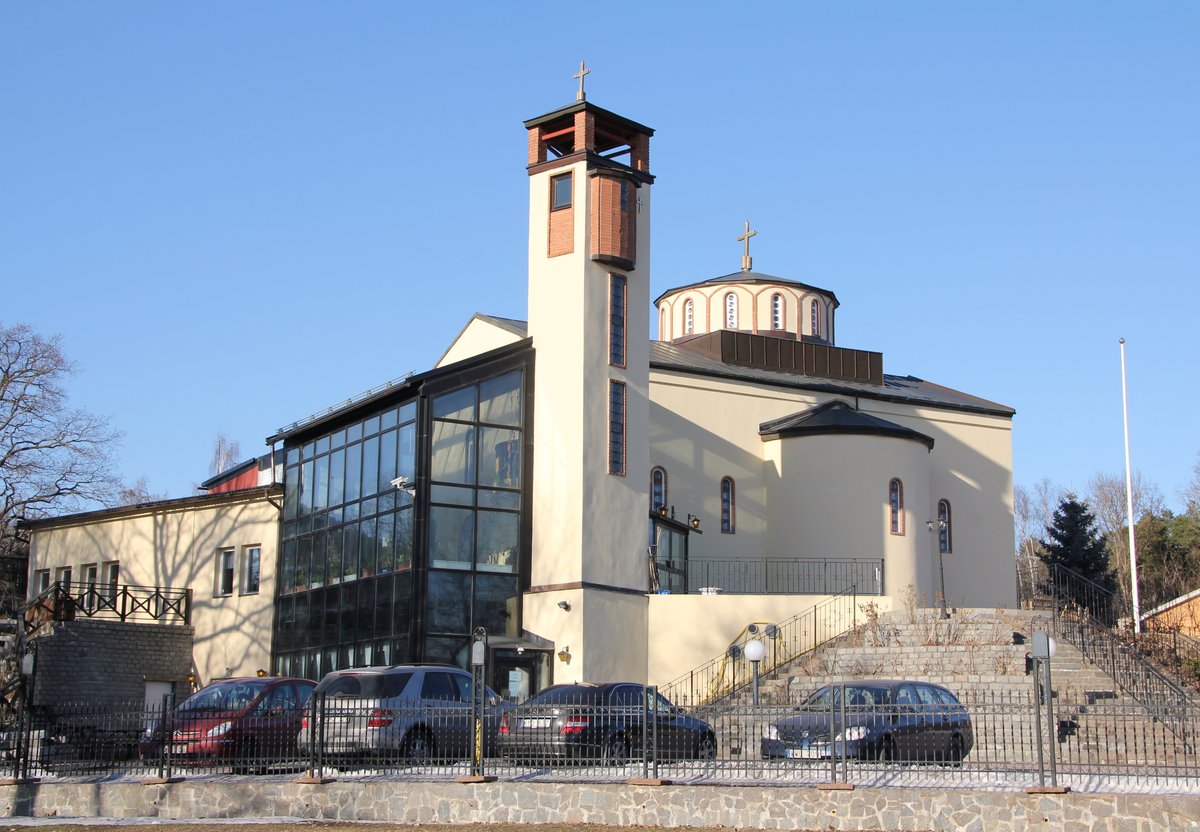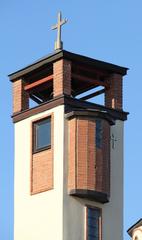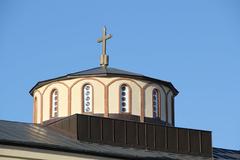
Saint Sava Serbian Orthodox Church Stockholm: Visiting Hours, Tickets, and Travel Guide
Date: 14/06/2025
Introduction
The Saint Sava Serbian Orthodox Church in Stockholm is a cornerstone of Serbian culture, faith, and community within Sweden’s capital. It serves not only as a place of worship for the Serbian diaspora but also as a guardian of cultural traditions, language, and identity, welcoming visitors of all backgrounds. This guide provides detailed historical context, architectural highlights, visiting information, and practical travel tips to enhance your experience at this vibrant cultural landmark.
Table of Contents
- Introduction
- Origins of the Serbian Orthodox Community in Sweden
- History and Development of Saint Sava Serbian Orthodox Church, Stockholm
- Architectural and Artistic Features
- Visiting Information
- Celebrations and Traditions
- Role in Modern Stockholm
- Frequently Asked Questions (FAQ)
- Visual and Interactive Features
- Summary and Travel Recommendations
- References and Further Resources
Origins of the Serbian Orthodox Community in Sweden
The Serbian Orthodox presence in Sweden originated in the aftermath of World War II and expanded significantly following the Yugoslav conflicts in the 1990s. Seeking to maintain their spiritual and cultural heritage, Serbian immigrants established a network of Orthodox parishes across Sweden. Stockholm, as the largest and most cosmopolitan city, became the epicenter for the Serbian community’s religious and cultural life. The founding of the Saint Sava Serbian Orthodox Church was a natural outcome of these efforts, providing a spiritual anchor and a venue for cultural preservation.
The church is dedicated to Saint Sava (1174–1236), the first Archbishop of the Serbian Orthodox Church and a pivotal figure in Serbian history. His legacy as a founder, educator, and patron saint of the Serbian people is celebrated each year on January 27th, known as Savindan (royalfamily.org, serbia.com).
History and Development of Saint Sava Serbian Orthodox Church, Stockholm
The Saint Sava Serbian Orthodox Church in Stockholm was established to address the spiritual needs of the burgeoning Serbian community and to serve as a beacon of cultural preservation. The congregation is part of the Serbian Orthodox Eparchy of Britain and Scandinavia, with the Stockholm church functioning as a central hub for religious services, festivals, and community gatherings.
Construction of the church began in 1990, with the cornerstone blessed by Bishops Dositheus and Lucian. The church was first used in 1991 and officially consecrated on October 5, 2014, by Serbian Patriarch Irenaeus, marking a significant milestone for the Serbian Orthodox community in Scandinavia (arhiva.spc.rs).
Architectural and Artistic Features
Exterior Design
The church’s architectural style draws inspiration from traditional Byzantine and Serbian Orthodox motifs, adapted to the Scandinavian context. Its most distinctive feature is the central dome, symbolizing the heavens and visible from afar, complemented by arched windows and entrances reminiscent of medieval Serbian monasteries. The understated façade blends harmoniously with the urban landscape, while the use of durable materials ensures the building withstands Stockholm’s climate (Wikipedia).
Interior Layout
Visitors enter through a spacious narthex into the main sanctuary. The cruciform layout is typical of Orthodox churches, with a central nave, side aisles, and an eastward-facing sanctuary separated by an intricately carved iconostasis. The iconostasis is adorned with hand-painted icons of Christ, the Virgin Mary, and Serbian saints, most notably Saint Sava. Frescoes and mosaics depicting biblical scenes and saints enrich the interior, creating an atmosphere of reverence and spiritual depth.
Liturgical and Artistic Elements
The altar, often crafted from marble or wood, is the focal point of the sanctuary. Brass chandeliers, embroidered altar cloths, and processional banners contribute to the church’s sacred ambiance. The dome’s ceiling may feature a fresco of Christ Pantocrator, underscoring the connection between the earthly and divine.
For more details on architectural significance, see (orthodoxtimes.com).
Visiting Information
Visiting Hours
- Monday to Saturday: 10:00 AM – 6:00 PM
- Sunday: 12:00 PM – 7:00 PM
- Divine Liturgies: Sundays and major Orthodox feast days, typically in the morning.
- Note: Hours may vary during religious holidays and special events. Always check the official website or contact the parish office for updates.
Tickets and Entry
- Admission: Free of charge; no tickets required.
- Donations: Welcomed and appreciated to support the church’s maintenance and community work.
Accessibility
- Wheelchair Access: Ramps at the main entrance; accessible restrooms; designated seating.
- Assistance: Available upon request; contact the church in advance for specific needs.
Guided Tours
- Availability: Offered on weekends and by appointment, especially for groups or during cultural festivals.
- Content: Tours typically cover the church’s history, art, and Orthodox rituals.
- Booking: Contact the parish office via the official website.
Photography and Visitor Etiquette
- Photography: Permitted outside services and with staff permission. Restricted during liturgies to maintain reverence.
- Dress Code: Modest attire recommended (shoulders and knees covered); hats removed inside the nave.
- Conduct: Maintain silence, especially during prayers. Mobile devices should be silenced.
Directions and Nearby Attractions
- Location: Enskede gård district, Stockholm.
- Public Transport: Metro (nearest station: [insert station name]), bus, and tram lines nearby.
- Parking: Limited street parking available; public transport is recommended.
- Nearby Sites: Enskede gård park, Gamla Stan (Old Town), Stockholm City Museum, and other notable churches (Stockholm10: Best Churches in Stockholm).
Celebrations and Traditions
The church is especially lively during major religious and cultural events:
- Savindan (Saint Sava’s Day, January 27): The most significant annual celebration, featuring festive liturgies, children’s recitations, and traditional Serbian music and dance (serbia.com).
- Krsna Slava: The family patron saint day, observed with rituals, Slava bread (kolač), and community feasting (serbia.com).
- Other Feasts: Christmas (Julian calendar), Easter, and feast days of Serbian saints, all marked with special liturgies and communal gatherings.
- Cultural Events: Language classes, folklore groups, charity initiatives, and educational workshops for all ages.
Role in Modern Stockholm
Today, the Saint Sava Serbian Orthodox Church fosters intercultural dialogue, community service, and educational outreach. Services are conducted in Serbian and Swedish, reflecting the integration of newer generations and mixed families. The church also collaborates with other Christian and cultural organizations, enhancing Stockholm’s multicultural fabric.
Through its programs and events, the church ensures the transmission of Serbian language, faith, and traditions to future generations, while inviting the broader public to participate and learn.
Frequently Asked Questions (FAQ)
Q: What are the visiting hours?
A: Monday to Saturday, 10:00 AM–6:00 PM; Sunday, 12:00 PM–7:00 PM. Check for updates during holidays.
Q: Is there an entrance fee?
A: No, entry is free. Donations are appreciated.
Q: Are guided tours available?
A: Yes, on weekends and by appointment.
Q: Is the church accessible for people with disabilities?
A: Yes, there are ramps and accessible facilities.
Q: Can I take photographs inside?
A: Yes, outside of services and with permission; photography is discouraged during liturgies.
Q: Can visitors attend services?
A: Yes, all are welcome; participation in sacraments like Holy Communion is reserved for baptized Orthodox Christians.
Visual and Interactive Features
The church’s official website and visitor center offer photo galleries, virtual tours, and video materials that showcase the architecture, iconography, and community life. High-quality images feature descriptive alt text such as “Saint Sava Serbian Orthodox Church interior Stockholm” and “iconostasis and dome.”

![]()
Summary and Travel Recommendations
The Saint Sava Serbian Orthodox Church in Stockholm is a living testament to Serbian heritage, resilience, and faith. With its evocative architecture, rich liturgical life, and vibrant cultural programming, the church welcomes both the Serbian diaspora and curious visitors seeking to explore Orthodox Christian traditions in Sweden. Its strategic location allows for easy combination with other Stockholm attractions, making it a highlight of any cultural itinerary.
For the most rewarding visit:
- Check the church’s official website for up-to-date schedules.
- Download the Audiala app for real-time cultural site information.
- Dress respectfully and observe Orthodox etiquette.
- Engage with community events for a deeper cultural experience.
For further reading and exploration, see:
- Saint Sava Serbian Orthodox Church – Historical Background
- Saint Sava’s Day and Serbian Cultural Heritage
- Architectural Features and Consecration
- Largest Orthodox Churches
- Saint Sava Church Official Ceremonies & Rituals






































































































































































